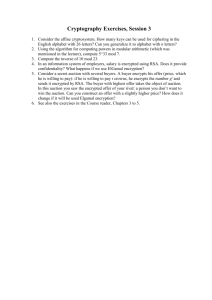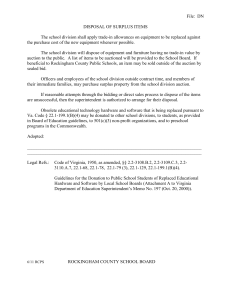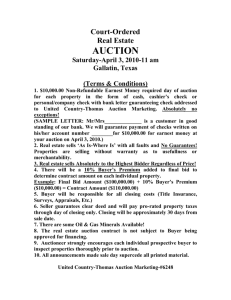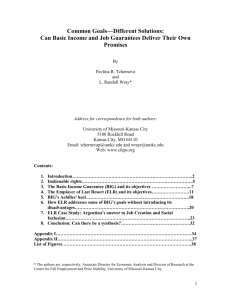Efficiency Loss in Revenue Optimal Auctions
advertisement
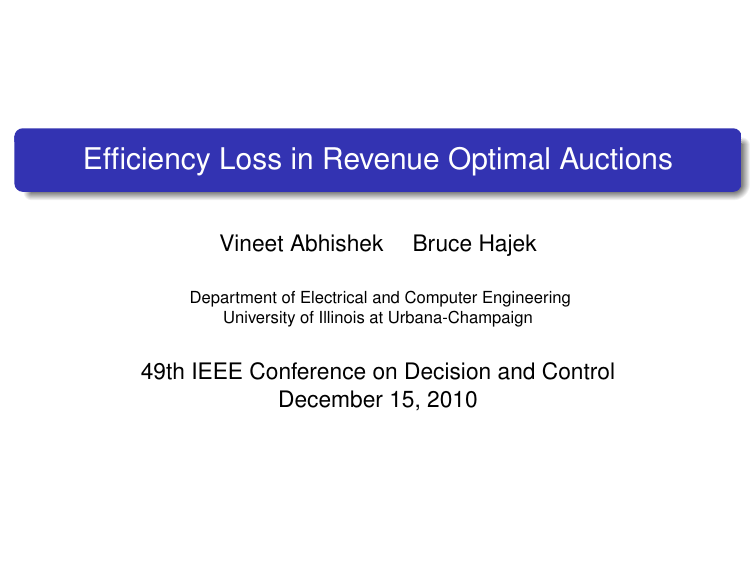
Efficiency Loss in Revenue Optimal Auctions
Vineet Abhishek
Bruce Hajek
Department of Electrical and Computer Engineering
University of Illinois at Urbana-Champaign
49th IEEE Conference on Decision and Control
December 15, 2010
Combinatorial Auctions (CAs)
Combinatorial Auctions (CAs):
A common framework for many resource allocation problems:
Seller - FCC.
Buyers - AT&T, Verizon, etc.
Items - spectrum licenses.
Buyers can compete for any bundle of items.
Allocation and payments based on the competition.
Objective - maximize revenue or social welfare.
The Two Objectives
Revenue optimal auction:
Maximize the seller’s revenue from sale.
Efficient auction:
Maximize the realized social welfare (RSW).
RSW = total value generated through the allocation of items.
An optimal auction is not efficient and vice versa.
Some Questions
How different is a revenue optimal auction from an efficient
auction?
What causes these differences?
How to quantify this difference?
What are the underlying parameters?
We answer these.
Model
N buyers, multiple items.
The bundles desired by the buyers are publicly known.
Each desired bundle has the same value for a buyer.
A buyer is a winner if he gets any one of his desired bundles.
A , collection of all possible sets of winners.
Assume that if A ∈ A and B ⊆ A, then B ∈ A (downward closed).
Model
A Bayesian framework
The value of a buyer n:
A realization of a discrete random variable Xn .
Xn ∈ {xn1 , xn2 , . . . , xnK }, where 0 ≤ xn1 < xn2 < . . . < xnK .
Assume Prob(Xn = xni ) > 0.
One-dimensional private information:
The exact realization of Xn is known only to buyer n.
Beliefs:
Xn ’s are independent across the buyers.
The probability distributions of Xn ’s are common knowledge.
The Components of an Auction
Winners
vN
Auction
.
.
Payment rule
M(v)
Buyer 1’s payment
p
y
.
.
.
Bid vector v
.
v1
Allocation rule
p(v)
Buyer N’s payment
π(v) = a probability distribution over A, given v.
πA (v) = prob that the set A of buyers are winners, given v.
The payoff of a buyer = value of the allocation - payment made.
Optimal and Efficient Auction Problems
Optimal auction problem:
"
maximize
E
π,M
N
X
#
Mn (X1 , X2 , . . . , XN ) ,
n=1
subject to: truth-telling and voluntary participation.
Efficient auction problem:
"
maximize
π,M
E
!#
X
πA (X1 , X2 , . . . , XN )
A∈A
subject to: truth-telling and voluntary participation.
X
n∈A
Xn
,
Optimal and Efficient Auction Characterization
Optimal allocation:
Compute monotone virtual valuation (MVV), wn (vn ), for each n.
X
∗
Set πA∗ (v) = 1 for some A ∈ argmax
wn (vn ) .
A∈A
n∈A
Efficient allocation:
Set πA∗ (v) = 1 for some A∗ ∈ argmax
A∈A
X
vn .
n∈A
Winner’s payment = the minimum he needs to bid to still win.
Revenue versus Efficiency
An optimal allocation can be different from an efficient allocation.
Maximizing the sum of MVVs versus the sum of actual bids.
MVVs can be negative; optimal auction can set reserve prices.
A buyer whose bid is below reserve price does not win.
The bids of the buyers can have a different rank ordering than
their MVVs.
In an optimal single-item auction, the winner is not necessarily
the highest bidder.
Quantifying Efficiency Loss
Realized Social Welfare (RSW) of an allocation rule π:
X
X πA (X)
Xn .
RSW(π, X; A) = E
A∈A
n∈A
Maximum social welfare (MSW) (for an efficient allocation):
X MSW(X; A) = E max
Xn .
A∈A
n∈A
The RSW of an optimal allocation ≤ MSW.
Quantifying Efficiency Loss
For an optimal allocation rule π o , define the efficiency loss ratio
(ELR) as:
ELR(π o , X; A) ,
MSW(X; A) − RSW(π o , X; A)
MSW(X; A)
The Worst Case ELR Problem
maximize
X
ELR(π o , X; A),
subject to: (maxn xnK )/(minn xn1 ) ≤ r .
Denote the worst case ELR by η(r , K ; A) for r ≥ 1 and K ≥ 1.
ELR Bounds
Binary valued buyers, not necessarily identically distributed:
The worst case ELR satisfies η(r , 2; A) ≤ (r − 1)/(2r − 1).
The worst case ELR for N buyers is no worse than it is for
single buyer.
Holds for arbitrary downward closed A.
The worst case ELR ≤ 1/2 uniformly over all r .
ELR Bounds
Single item with i.i.d. buyers, not necessarily binary valuations:
Reduction to an optimization problem involving only the common
probability vector of the buyers.
Lower and upper bounds (asymptotically tight as K → ∞) on the
worst case ELR.
The worst case ELR → 0 as N → ∞ at the rate O (1 − 1/r )N .
The worst case ELR → 1 as K → ∞ and r → ∞.
Concluding Remarks
Optimality and efficiency are the two prevalent themes in
auction theory.
Trade-off between these two objectives in terms of ELR.
Worst case bounds on ELR.
A revenue optimal auction can be very different from an
efficient auction.

